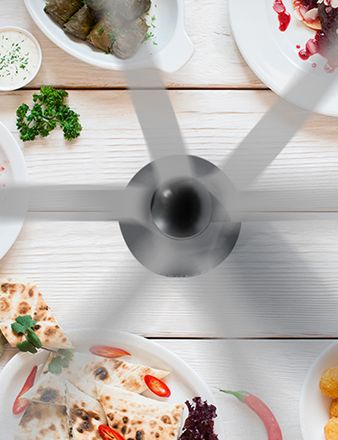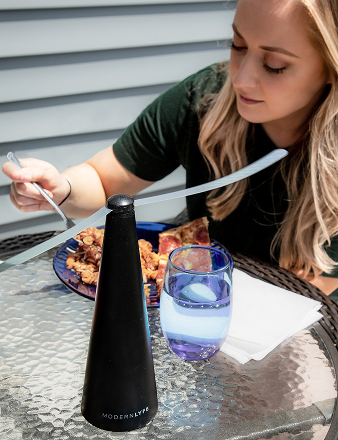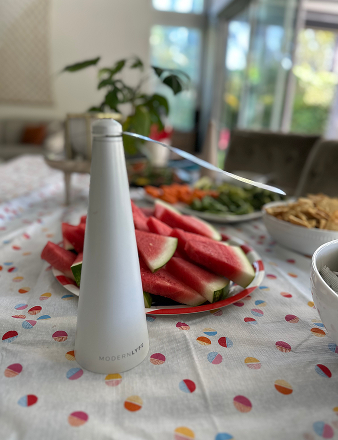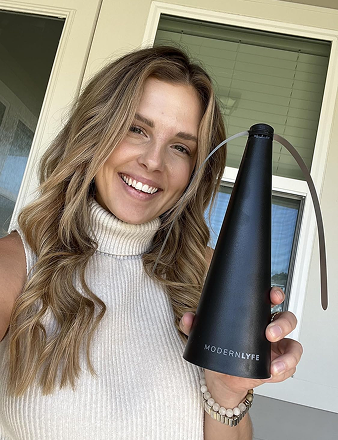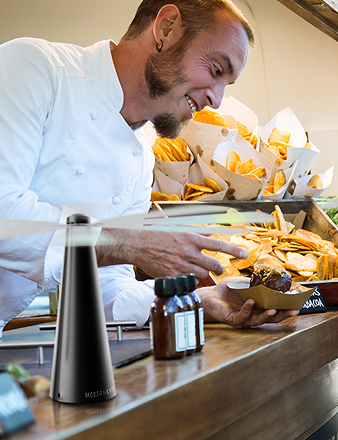You're trying to enjoy a meal outdoors, but uninvited guests have arrived: flies. You spend more time swatting than eating, and the frustration is real.
Traditional sprays are smelly and sticky traps are an eyesore. There's a better, safer, and more elegant way to keep pests away from your food.
Meet the fly fan repellent. This simple device is engineered to create a fly-free zone around your table, using a clever, chemical-free method.
How It Works: A Smart, Chemical-Free Solution
A fly fan repellent is a simple, battery-operated device with soft, flexible blades. It works by disrupting a fly's senses in two key ways.
First, the spinning blades create a gentle, consistent air current. Flies are weak fliers, and this disturbance makes it difficult for them to navigate and land near your food. It’s an invisible barrier they can't easily cross.
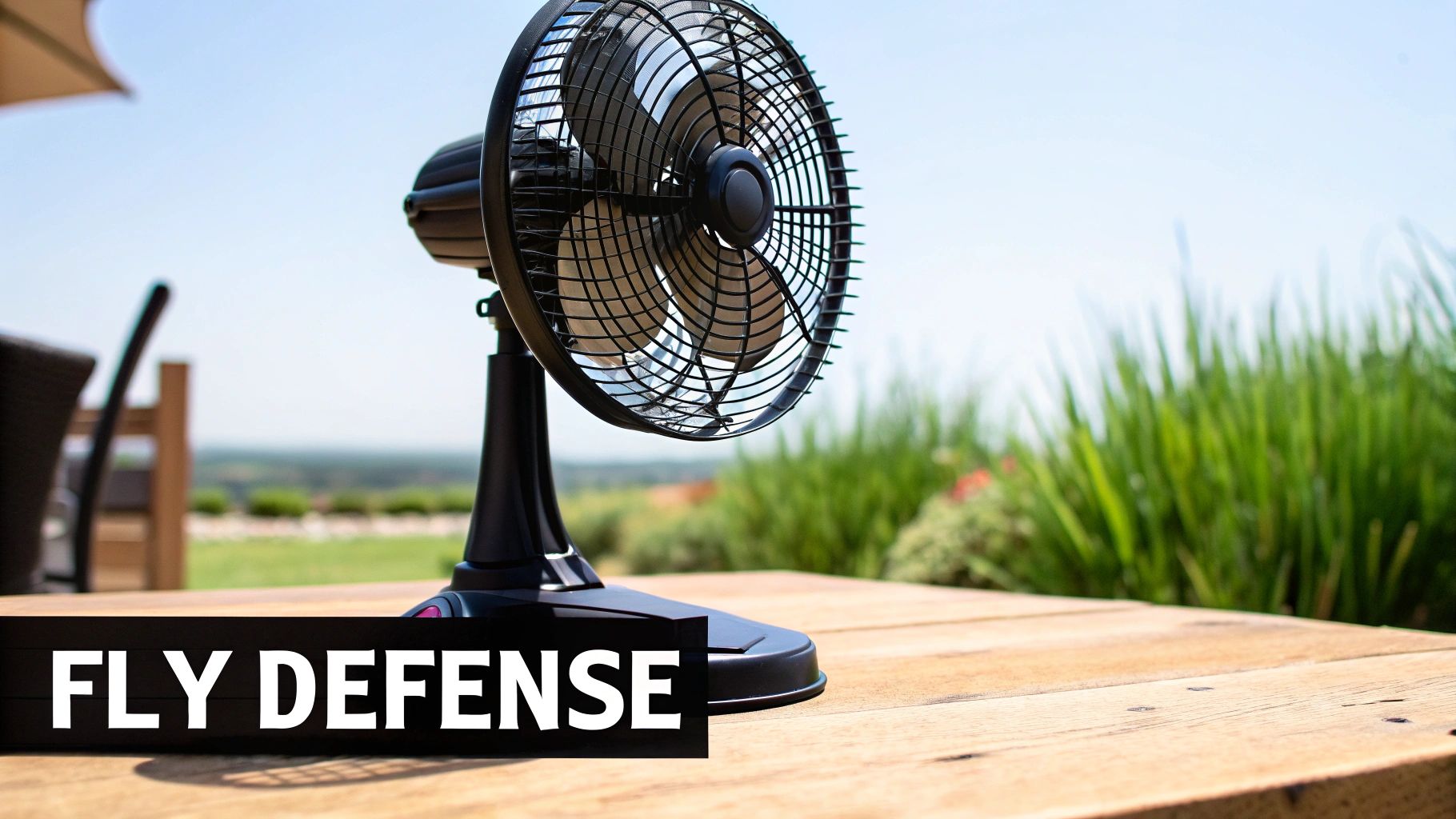
Second, the blades feature a holographic pattern. As they spin, this pattern refracts light, creating an erratic visual that disorients a fly's compound eyes. To a fly, this confusing light show signals danger, causing it to steer clear.
The result is a silent, odor-free barrier over your food without chemicals or zapping sounds.
A Smarter Approach to an Old Problem
Demand for better insect control is rising. Consumers are seeking effective, safe solutions that don’t rely on harsh chemicals around their families and food. This trend is reflected in market data, with the global fly repellent industry valued at USD 2.7 billion in 2022 and projected to grow by 5.6% annually through 2031.
This guide explains everything you need to know about this innovative device:
- The technology that deters flies without contact.
- Key benefits for homes, restaurants, and outdoor events.
- Tips for optimal placement and easy maintenance.
The goal is to let you enjoy your meals in peace. A fly fan repellent reclaims your space from the constant annoyance of buzzing pests.
For more ideas on protecting your food, read our guide on how to keep flies away from food.
Let's explore how to make buzzing pests a thing of the past.
How Gentle Breezes and Light Keep Flies Away
The science behind a fly fan repellent is simple but effective. Instead of chemicals or traps, it uses a fly’s own senses against it to create an invisible, protective barrier. It works through a two-part system: air movement and visual disruption.

The first element is the constant, gentle air current from the soft, spinning blades. While you’ll barely feel this breeze, it's a significant obstacle for a fly. As lightweight insects and poor fliers, they struggle to navigate through disturbed air. Trying to land on your food becomes nearly impossible, so they move on to find an easier target.
The Power of Visual Disruption
The second line of defense targets a fly's vision. Flies have compound eyes, composed of thousands of individual lenses. This makes them highly sensitive to movement and light, but also easy to overwhelm.
The blades on a fly fan repellent feature a reflective, holographic pattern. As the blades spin, this pattern catches and scatters light in all directions.
To a fly, this creates a chaotic and disorienting light show that its brain registers as a threat. The unpredictable flashes create a visual "danger zone" that a fly instinctively avoids.
This is why you'll see a fly approach the fan, hesitate, and then fly away. It isn't afraid of the fan itself but is deterred by the confusing and threatening visual environment it creates.
Combining Forces for a Fly-Free Zone
Together, the breeze and the flashing lights create a powerful, multi-layered deterrent.
- Physical Deterrence: The air movement physically prevents flies from landing by disrupting their flight path.
- Sensory Deterrence: The refracted light from the holographic blades visually confuses the flies, signaling a hazardous area they instinctively avoid.
The outcome is a silent, odorless, and invisible dome of protection over your table. This process is completely harmless to people, pets, and your food. It’s a smart, elegant solution based on fly biology.
The Real-World Benefits of a Chemical-Free Solution
A fly fan offers significant practical advantages for any setting, starting with its biggest feature: it’s completely chemical-free. This provides peace of mind, especially around children, pets, and guests with sensitivities. You can place it directly beside a platter of food or a cake without any concern.
This is a stark contrast to chemical sprays that leave behind unpleasant odors and potentially harmful residue on surfaces and food. The shift toward safer, cleaner alternatives is a major driver of the fly fan's popularity.
Enjoy Uninterrupted Ambiance
Another key benefit is their quiet and discreet operation. Unlike loud, buzzing zappers that add noise to your gathering, a quality fly fan runs almost silently. Its faint hum is barely noticeable, ensuring it won't interrupt conversations or disrupt a peaceful meal.
The purpose is to eliminate a distraction, not create a new one. This makes it ideal for everything from family dinners to the patios of upscale restaurants where ambiance is critical.
The real value of a fly fan is in what it doesn't do. It doesn't use chemicals, make noise, or leave a mess. It simply lets you enjoy the moment.
The data below highlights the effectiveness and economy of these devices.
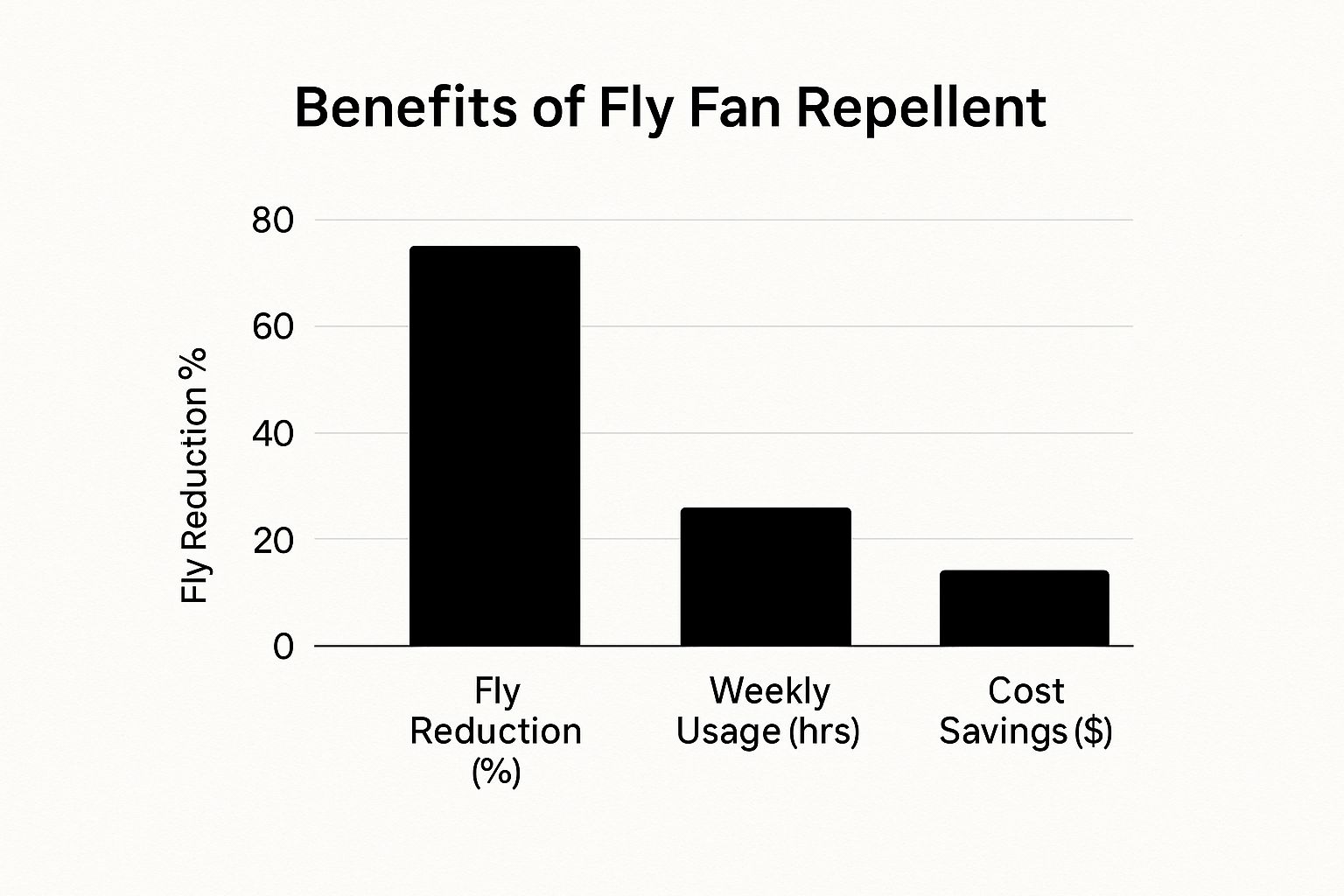
The numbers demonstrate a significant reduction in fly activity and long-term cost savings.
Portability and Sustainable Savings
The unmatched portability of battery-powered models makes them incredibly versatile. You can take one anywhere—from a campsite to a beach picnic—and instantly create a fly-free zone. Businesses appreciate their flexibility, easily moving them between tables to adapt to customer flow.
This adaptability is a key factor in the booming fly repellent market, which reached USD 4.64 billion in 2023 and is projected to hit USD 8.32 billion by 2030. This growth indicates strong consumer demand for effective, portable solutions. Learn more about the fly repellent market growth on maximizemarketresearch.com.
Finally, consider the long-term savings and sustainability. A fly fan is a one-time purchase, eliminating the recurring cost of sprays or disposable traps. This saves money and reduces waste, making it an environmentally friendly choice for pest control.
Fly Fan Repellent vs Traditional Methods
A direct comparison shows why a fly fan is a significant upgrade over older methods, which often come with undesirable trade-offs.
| Feature | Fly Fan Repellent | Chemical Sprays | Citronella Candles |
|---|---|---|---|
| Safety | Chemical-free; safe around food, kids, and pets. | Contains insecticides; potential for residue on surfaces. | Produces smoke and soot; open flame is a fire hazard. |
| Ambiance | Near-silent operation preserves a peaceful atmosphere. | Strong, unpleasant chemical odor. | Strong scent can be overpowering. |
| Effectiveness | Highly effective in a defined area; works instantly. | Requires repeated application; effectiveness can vary. | Limited effectiveness, highly dependent on wind. |
| Cost | One-time purchase for long-term savings. | Ongoing cost of replacement cans. | Must be continuously replaced. |
| Environmental | Reusable and reduces waste. | Aerosol cans and chemical runoff harm the environment. | Releases smoke and particulates into the air. |
The comparison makes it clear: fly fans offer a modern, effective, and responsible alternative that solves the problem without creating new ones.
How to Choose the Right Fly Fan for Your Needs
Choosing the right fly fan repellent is simple when you focus on a few key factors. Consider where and how you'll use it to find the perfect match, whether for a backyard barbecue or a busy restaurant patio.
Start by thinking about your primary use case. Do you need a portable device for camping trips or a more permanent solution for an outdoor dining area? Each scenario benefits from different features.

Power Source and Portability
Power source dictates the fan's portability and placement options. The three main types are:
- Disposable Batteries (AA): This classic option offers maximum portability, perfect for picnics, camping, or any location without an outlet. The only downside is the recurring cost of batteries.
- USB-Rechargeable: A more sustainable and budget-friendly choice. These models can be charged via a power bank, laptop, or wall adapter, providing excellent flexibility. A single charge typically lasts for several hours.
- Plug-In (AC Adapter): Best for fixed locations like a home patio or restaurant seating area. This option provides consistent, reliable power without concerns about batteries dying.
Design and Safety Features
The blades are crucial for both performance and safety. Always choose a model with soft, flexible blades. This is a critical safety feature, ensuring the blades stop instantly and harmlessly upon contact with a hand or object.
Examine the holographic patterns on the blades. Quality fans use patterns engineered to refract light in a way that effectively disorients flies. Blade length also matters; longer blades create a larger protective zone. Our complete guide to the fly repellent fan provides more detail on these design elements.
The right combination of blade length and an effective holographic pattern determines the fan's coverage area. A single well-designed fan can often protect a standard four-person table.
The market for smarter pest control is expanding rapidly. The global flies repellent market is expected to grow from USD 3.96 billion to USD 5.97 billion between 2024 and 2030, showing a clear consumer shift toward specialized tools. You can explore the diverse fly repellent market on researchandmarkets.com to see the trends.
Bonus Features to Consider
Look for extra features that add convenience. A built-in hook at the base allows you to hang the fan upside down over a buffet or picnic blanket. Some models offer multiple speed settings for more control over the airflow. These small details can significantly improve the user experience.
Perfect Placement for a Pest-Free Zone
To maximize your fly fan's effectiveness, strategic placement is key. Think of it as creating a defensive perimeter around your food.
The golden rule is to place the fan as close to the center of your food spread as possible. Set it on the dining table, next to the main dishes on a buffet, or beside a charcuterie board. This central position ensures the air currents and light patterns cover the most critical areas effectively.
Ensure the blades have room to spin without obstruction. Avoid placing it behind tall objects like vases or bottles, as this will block airflow and reduce the size of the protective zone. The goal is a clear line of sight for the spinning blades across the entire food area.
Sizing Up Your Space
For larger setups, one fan may not be enough. Match the number of fans to the size of your table to ensure complete coverage.
Follow these simple guidelines:
- Small Round or Square Tables: For a standard four-person table, one centrally placed fly fan repellent is usually sufficient.
- Long Rectangular Tables: For tables seating six or more, use two fans. Place one at each end to create an overlapping protective field along the entire length.
- Large Buffet Setups: For large buffet lines, place a fan every four to six feet to ensure there are no gaps for flies to exploit.
The goal is to create overlapping zones of protection, forming an unbroken, invisible barrier that shields every dish.
Common Placement Mistakes to Avoid
Even the best fan is ineffective if placed incorrectly. Common mistakes can compromise its performance, leaving you wondering why flies are still present.
The biggest error is placing the fan too far from the food, such as on a side table or the floor. These fans have an effective range of about three to four feet, so keeping them central is crucial. It's also important to remember that a single fan is designed for targeted, localized defense, not for protecting an entire patio.
Learn more about how to banish buzzing pests with the Modern Lyfe Fly Fan for tables in our detailed guide. Avoid these simple mistakes to keep your dining area a peaceful, fly-free sanctuary.
Keeping Your Fly Fan in Fighting Shape
Maintaining your fly fan repellent is simple and requires minimal effort. A few good habits will ensure it’s always ready to protect your meals.
The most important task is keeping the blades clean. Dust and grime can accumulate over time, dulling the reflective patterns that deter flies. Simply wipe the blades with a soft, damp cloth. Avoid harsh chemical cleaners or abrasive pads that can scratch the holographic surface and reduce its effectiveness.
Batteries and Off-Season Storage
Proper battery care is essential for the fan's longevity. Whether you use disposable or rechargeable batteries, remove them before storing the fan for an extended period, such as over the winter. This simple step prevents battery leakage and corrosion, which can permanently damage the device.
When patio season is over, store your fan in a cool, dry place. Follow this quick end-of-season checklist:
- Wipe Down the Blades: Remove any lingering dust.
- Remove the Batteries: Prevent corrosion and damage.
- Find a Safe Spot: The original box is ideal, but any shelf away from direct sunlight works well.
Taking two minutes to store your fan correctly ensures it will be ready to use as soon as the warm weather returns. A little care goes a long way.
Quick Fixes for Common Hiccups
If your fan seems sluggish or stops spinning, the fix is usually simple. First, check the batteries. In over 90% of cases, weak or dead batteries are the cause.
If fresh batteries don't solve the problem, check for obstructions. A piece of string or debris can sometimes get caught in the motor or blades. A quick visual inspection and gentle cleaning will typically get it spinning again.
Got Questions? We've Got Answers
Here are answers to the most common questions about fly fan repellents to help you get the best results.
Are These Things Loud?
Not at all. A key feature of a quality fly fan is its near-silent operation. They are engineered to blend into the background, so they won't disrupt conversations or a quiet meal. The motors are designed for smooth, quiet performance.
Does It Work on Mosquitoes, Bees, or Other Bugs?
A fly fan is a specialized tool designed to disrupt a fly's vision and flight. While the air movement might deter some smaller insects like gnats, it is not effective against larger or more determined pests like bees and wasps. They are generally unbothered by a gentle breeze or reflective light.
Think of it this way: the fan's combination of light and air is tuned to a fly's specific sensitivities, but other insects operate on a different frequency.
How Many Fans Should I Put on My Table?
This depends on the size of your table and your gathering. A good rule of thumb is:
- 1 fan is generally enough for a standard round or square table seating 4 to 6 people.
- 2 fans are ideal for longer, rectangular tables. Place one at each end to create an overlapping zone of protection.
- For large events with multiple tables, place fans strategically throughout the area.
Are the Blades Dangerous for My Kids or Pets?
No, they are completely safe by design. The blades are made of a soft, flexible material that cannot cause injury.
They also feature a safety-stop mechanism. The moment a blade touches an object—like a child's hand or a pet's nose—it stops spinning instantly. It resumes once the obstruction is cleared, making it a worry-free choice for families.
Ready to reclaim your patio and enjoy meals without swatting? The MODERN LYFE fly fan repellent offers a quiet, safe, and stylish solution. Shop now and see the difference it makes.

